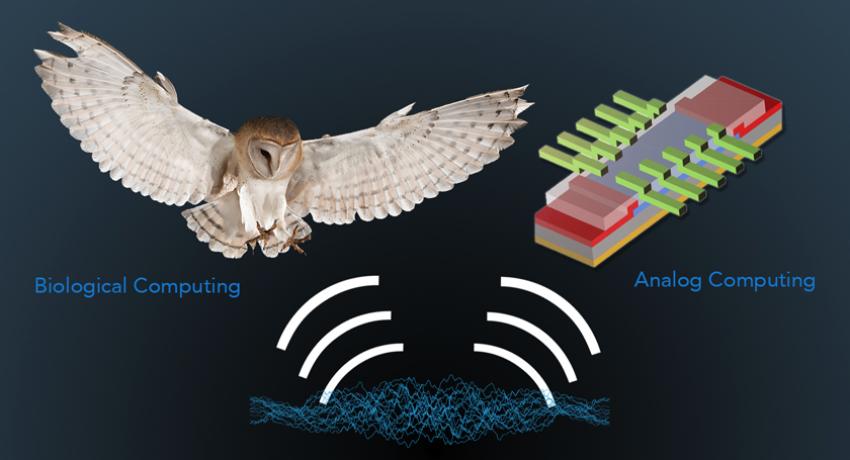Artists rendition of an electronic device mimicking the barn owl brain circuitry. Image: Jennifer M. McCann / Penn State MRI
The way barn owl brains use sound to locate prey may be a template for electronic directional navigation devices, according to a team of Penn State engineers who are recreating owl brain circuitry in electronics.
"We were already studying this type of circuit when we stumbled across the Jeffress model of sound localization," said Saptarshi Das, assistant professor of Engineering Science and Mechanics.
The Jeffress model, developed by Lloyd Jeffress in 1948, explains how biological hearing systems can register and analyze small differences in the arrival time of sound to the ears and then locate the sound's source.
"Owls figure out which direction sound is coming from to within one to two degrees," said Saptarshi Das. "Humans are not that precise. Owls use this ability for hunting especially because they hunt at night and their eyesight isn't all that good."
The ability to use sound to locate relies on the distance between the ears. In barn owls, that distance is quite small, but the brains circuitry has adapted to be able to discriminate this small difference. If the owl is facing the sound source, then both ears receive the sound simultaneously. If the sound is off to the right, the right ear registers the sound slightly before the left.
However, locating objects by sound is not that simple. The speed of sound is faster than the owl's nerves can function so after the owl converts sound to an electrical pulse, the pulse is slowed down, then the brain's circuitry uses a lattice of nerves of different length with input from two ends, to determine which length is where the two signals coincide — arrive at the same time. This provides the direction.
Saptarshi Das and his team have created an electronic circuit that can slow the circuit and determine the coincidence point.
The researchers, who include Saptarshi Das; Akhil Dodda, graduate student in engineering science and mechanics; and Sarbashis Das, graduate student in electrical engineering, note today (Aug 1.) in Nature Communications that "the precision of the biomimetic device can supersede the barn owl by orders of magnitude.
The team created a series of split-gate molybdenum sulfide transistors to mimic the coincidence nerve network in the owl's brain. Split gat transistors only produce output when both sides of the gate match, so only the gate tuned to a specific length will register the sound. The biomimetic circuitry also uses a time delay mechanism to slow down the signal.
While this proof of concept circuit uses standard substrates and device types, the researchers believe that using 2D materials for the devices would make them more accurate and also more energy efficient, because the number of split-gate transistors could be increased providing more precise coincidence times. This would benefit devices run on batteries in remote locations.
However, having only the direction will not provide the location of the sound source. To actually navigate or locate, a device would need to know the height of an object as well. Saptarshi Das notes that height is a property of the intensity of the sound and the researchers are working on this aspect of the problem.
"There are several animals that have excellent sensory processing for sight, hearing and smell," said Saptarshi Das. "Humans are not the best at these."
The team is now looking at other animals and other sensory circuitry for future research. Saptarshi Das considers this a paradigm change in his research.
"Animals have had millions of years to evolve and only the best solutions have survived," said Sarbashis Das. "Now, we just have to learn how they do those things."
The Air Force Office of Scientific Research supported this work. The researchers have filed for a provisional patent on this work.

